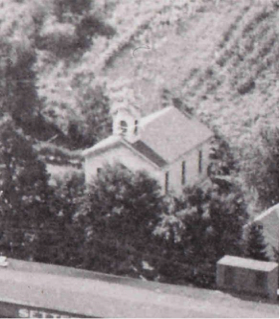 The history of the Roman Catholic presence in Cattaraugus Village is thoroughly influenced by the area’s earliest residents. Three groups of railroad builders were the first significant population to choose to live in the area. They arrived in 1849 as railroad workers on the New York and Lake Erie Railroad that was being constructed at that time. Two of the work crews were Irish Catholics and the third were German Lutherans. Most of the Irish lived and worked in the area north of the railroad tracks in Cattaraugus Village. Upon completion in 1851, many of the workers chose to stay and make their lives in the community. The locals called this area “The Patch,” a reference to potato patches and the reason so many left Ireland. The Catholics gathered together in The Patch for church services. This church was incorporated on December 12, 1863, and was named St. Mary’s Church. Masses and meetings were held in people’s homes at first. Soon, one of the Irish-owned businesses provided appropriate worship space for the masses, which were conducted every two weeks as priests became available. Priests arrived by train either from Dayton or St. Bonaventure College in Allegany.
The history of the Roman Catholic presence in Cattaraugus Village is thoroughly influenced by the area’s earliest residents. Three groups of railroad builders were the first significant population to choose to live in the area. They arrived in 1849 as railroad workers on the New York and Lake Erie Railroad that was being constructed at that time. Two of the work crews were Irish Catholics and the third were German Lutherans. Most of the Irish lived and worked in the area north of the railroad tracks in Cattaraugus Village. Upon completion in 1851, many of the workers chose to stay and make their lives in the community. The locals called this area “The Patch,” a reference to potato patches and the reason so many left Ireland. The Catholics gathered together in The Patch for church services. This church was incorporated on December 12, 1863, and was named St. Mary’s Church. Masses and meetings were held in people’s homes at first. Soon, one of the Irish-owned businesses provided appropriate worship space for the masses, which were conducted every two weeks as priests became available. Priests arrived by train either from Dayton or St. Bonaventure College in Allegany.
In 1886, the first St. Mary’s Church was constructed on Mill Street in The Patch of Cattaraugus Village. The wooden structure was built primarily through the efforts of the McCarthys, Kelleys, Crowleys and Carrolls. The structure was small and plain but had nine magnificent stained glass windows, a bell tower and a cross on the bell tower. It was the highest elevation of any church in the village and was clearly visible from across the valley. It was a joyous celebration when the first service was held.
 In 1907, Bishop Colton appointed Fr. William Krampf as the first resident pastor. A rectory was purchased in 1908 next to the church on Mill Street. Also in 1907, St. Mary’s Church in Little Valley was assigned to Cattaraugus. Fr. Krampf served both parishes until he was transferred in 1912. His successor, Fr. John Duggan, a native of Ireland, administered the faith to the members of the parish until his death in November 1939. Fr. Duggan is buried in Liberty Park Cemetery in Cattaraugus. Father Norman O’Meara arrived in 1939. He was a vivacious pastor and his hard work and dedication succeeded in improving the parish and increasing membership. His efforts contributed to the activation of various societies that endure to this day. He held summer vacation school with seminarians as teachers. Fr. Norm was a professional baseball player before his ordination and he often played on the local team. Fr. Norm was transferred to Cuba, NY in July 1945.
In 1907, Bishop Colton appointed Fr. William Krampf as the first resident pastor. A rectory was purchased in 1908 next to the church on Mill Street. Also in 1907, St. Mary’s Church in Little Valley was assigned to Cattaraugus. Fr. Krampf served both parishes until he was transferred in 1912. His successor, Fr. John Duggan, a native of Ireland, administered the faith to the members of the parish until his death in November 1939. Fr. Duggan is buried in Liberty Park Cemetery in Cattaraugus. Father Norman O’Meara arrived in 1939. He was a vivacious pastor and his hard work and dedication succeeded in improving the parish and increasing membership. His efforts contributed to the activation of various societies that endure to this day. He held summer vacation school with seminarians as teachers. Fr. Norm was a professional baseball player before his ordination and he often played on the local team. Fr. Norm was transferred to Cuba, NY in July 1945.
The Cattaraugus parishioners held benefit dinners in the Grange Hall, the Opera House, and the Palace Theatre. They also organized lawn fetes and many dozens of dinners, dances and religious fellowship events over the course of the following years. Fr. Richard Deasey followed Fr. O’Meara and was a very popular pastor from 1945 through 1948.


In 1948, St. Mary’s in Cattaraugus was named the Missionary Apostolate Headquarters due to its location in the geographic center of the southern tier of Western New York State. The Missionary Apostolate was the creation of Bishop Duffy, along with Fr. James Navagh, who established mission areas in the diocese as a means to bring the full benefits of the church to rural areas. As the center of the Missionary Apostolate, priests and seminarians stayed in Cattaraugus and traveled to the three-county rural area of the diocese to minister to the local people.
Full History